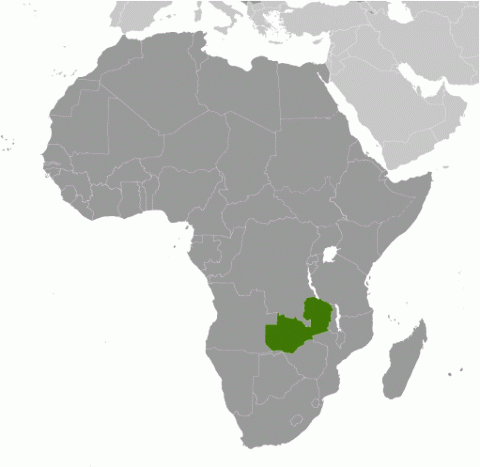Child Labor and Forced Labor Reports
Zambia


Moderate Advancement
In 2024, Zambia made moderate advancement in efforts to eliminate the worst forms of child labor. The government allocated 15 percent of its national budget—a little over $1.4 billion—to education programs, including teacher recruitment, school feeding programs, and school construction. The government also established the Anti-Human Trafficking Department, which hired 16 permanent officers and trained over 2,000 officials on how to identify trafficking in persons and provide support to survivors. However, despite these efforts, Zambia’s laws do not meet international standards on education because the Education Act does not specify a compulsory attendance age. Despite having a mandate to do so, labor inspectors do not inspect the informal sector, which comprises 76 percent of Zambia’s economic activity and in which most incidents of child labor occur. Although the Ministry of Labor and Social Security operates a hotline to receive labor-related complaints, “child labor” is not one of the tracked complaint categories, which hinders the ability to aggregate and publish reports of child labor violations. In addition, the government did not impose civil penalties for child labor violations and did not take efforts to implement the National Action Plan for the Elimination of the Worst Forms of Child Labor.
| Children | Age | Percent and Population |
|---|---|---|
| Working | 5 to 14 | 7.8% (400,423) |
| Attending School | 5 to 14 | 74.6% |
| Combining Work and School | 7 to 14 | 7.1% |
| Sectory/Industry | Percent of Population |
|---|---|
| Agriculture | 94.6% |
| Industry | 1.1% |
| Services | 4.3% |
| Sector/Industry | Activity |
|---|---|
| Agriculture | Agriculture, including the production of cotton† and tobacco.† Raising and herding† of cattle. Forestry, including logging.† Fishing.† |
| Industry | Mining, including in copper, manganese, and gemstone production; including exposure to lead,† working underground† and scavenging for ore. Working in stone quarries and construction, carrying heavy loads† and crushing stones.† Working in manufacturing. |
| Services | Domestic work and street work, including begging, vending, washing cars, piecework as porters, and garbage disposal. |
| Categorical Worst Forms of Child Labor‡ | Forced labor in agriculture and herding, mining, construction, and weaving reed furniture. Street vending of food and selling retail goods in markets. Domestic work. Commercial sexual exploitation, particularly around mines. Forced begging. Use in illicit activities, including the selling of illegal drugs. |
† Determined by national law or regulation as hazardous and, as such, relevant to Article 3(d) of ILO C. 182.
‡ Child labor understood as the worst forms of child labor per se under Article 3(a)–(c) of ILO C. 182.
Children at Higher Risk
Children near artisanal mining sites are more vulnerable to engaging in mining activities and vending foodstuffs. Illegal mining syndicates, called jérabo gangs, have been known to kidnap street boys in the mining provinces to scavenge slag heaps and load trucks with stolen copper ore, under threat of bodily harm. Young girls in drought-affected communities, near mining sites, and along Zambia’s borders and transit corridors are particularly vulnerable to commercial sexual exploitation. Children moving from rural areas to urban areas and asylum seekers are at particular risk of forced labor. In addition, refugee children have increased vulnerability to labor exploitation.
Barriers to Education Access
Girls face multiple barriers to education due to early marriage, teenage pregnancy, and traditional roles, particularly in rural areas. Studies show that only 27 percent of girls in Zambia complete upper secondary school, and among the poorest this figure falls to 3 percent. Due to Zambia’s high poverty rate, the cost of basic school supplies and suitable school clothing can create a barrier for many students. In rural areas, many students must travel significant distances by foot to and from school. While the government has increased the number of teachers nationwide by more than 30,000 since the beginning of 2021, its policy of free education through high school has led to a significant increase in enrollment. As a result, the teacher-student ratio has remained high, averaging 1:58 in 2024. According to Zambia’s Education Management Information System, in 2020, 24 percent of school toilets were either temporary or not working. Lack of toilets, poor sanitation, and a lack of bathroom privacy can be a barrier to attendance, especially for girls. Local NGOs report that teachers are known to demand sexual payment from girls for school access, including for books, fees, and grades. In addition, increasing food insecurity and limited availability of school lunches are barriers to attendance. In certain cases, mining activity near schools has negatively affected the school’s potable water supply, leading to increased incidences of student illness and contributing to absenteeism. The recruitment of children for work in mining and agricultural activities was also noted as a primary cause of absenteeism, particularly in the Luapula Province.
| Standard | Age | Meets International Standards | Legislation |
|---|---|---|---|
| Minimum Age for Work | 15 | ✓ | Article 24 of the Constitution; Sections 16 and 81 of the Employment Code Act; Section 13 of the Children’s Code Act of 2022 |
| Minimum Age for Hazardous Work | 18 | ✓ | Section 83 of the Employment Code Act; Section 13 of the Children’s Code Act of 2022, Article 266 of the Constitution |
| Identification of Hazardous Occupations or Activities Prohibited for Children | ✓ | Prohibition of Employment of Young Persons and Children (Hazardous Labor) Order; Section 137(2)(n) of the Employment Code Act | |
| Prohibition of Slavery, Debt Bondage, and Forced Labor | ✓ | Articles 14 and 24 of the Constitution; Sections 143, 261, and 263 of the Penal Code; Sections 2 and 3 of the Anti-Human Trafficking Act; Section 8 of the Employment Code Act | |
| Prohibition of Child Trafficking | ✓ | Article 24(3) of the Constitution; Section 143 of the Penal Code; Sections 2, 3, and 3A of the Anti-Human Trafficking Act, as amended by the Anti-Human Trafficking (Amendment) Act of 2022; Sections 80 and 83 of the Employment Code Act; Section 17 of the Children’s Code Act | |
| Prohibition of Commercial Sexual Exploitation of Children | ✓ | Sections 143 and 144 of the Penal Code; Sections 80 and 83 of the Employment Code Act; Articles 19 and 27 of the Children’s Code Act of 2022 | |
| Prohibition of Using Children in Illicit Activities | ✓ | Sections 80 and 83 of the Employment Code Act; Section 20 of the Children’s Code Act of 2022 | |
| Minimum Age for Voluntary State Military Recruitment | 18 | ✓ | Section 14 of the Defense Act |
| Prohibition of Compulsory Recruitment of Children by (State) Military | N/A* | ||
| Prohibition of Military Recruitment by Non-state Armed Groups | ✓ | Section 3 of the Anti-Human Trafficking Act; Sections 80 and 83 of the Employment Code Act; Section 14 of the Children’s Code Act of 2022 | |
| Compulsory Education Age | ✗ | Sections 2 and 16 of the Education Act | |
| Free Public Education | ✓ | Sections 2, 15, and 17 of the Education Act |
* Country has no conscription
The law establishes a light work framework for employment of children ages 13 to 15 but does not specify which work activities are permissible, the conditions in which light work may be undertaken, or limit the number of hours for light work. The Education Act requires that the government provide free education up to the ninth grade and stipulates that education is compulsory for children of “school-going age.” However, it neither defines the school-going age nor indicates the age of completion of compulsory schooling. This creates ambiguity regarding parental obligations for assuring initial enrollment, attendance, and completion. It also allows children to leave school before they are legally able to work, thereby increasing their vulnerability to the worst forms of child labor.
| Organization/Agency | Role & Activities |
|---|
| Ministry of Labor and Social Security (MLSS): Conducts labor inspections in registered private institutions in response to complaints such as unpaid wages, abuse of workers, and safety violations. Also oversees the National Steering Committee on Child Labor (NSCCL). In 2024, the MLSS was active. However, the MLSS did not impose penalties for child labor violations, and its hotline to receive labor-related complaints does not track child labor as a distinct complaint category. |
| Criminal Enforcement Agencies: The Zambia Police Service (ZPS) collaborates with the Ministry of Justice to investigate and prosecute child labor cases. The ZPS is responsible for enforcing laws against child trafficking, commercial sexual exploitation, and the use of children in illicit activities through its Child Protection Units; these units work with immigration and local officials to respond to child trafficking and remove vulnerable children from the streets, placing them into families, foster homes, or in safe homes. The Ministry of Home Affairs and Internal Security (MOHAIS) is responsible for enforcing criminal laws against human trafficking and the worst forms of child labor through its Immigration Department, Drug Enforcement Commission, and the newly created Anti-Human Trafficking Department (AHTD). In 2024, the AHTD trained over 2,000 officials on identifying signs of trafficking in persons, including children, and received $306,000 to hire 16 permanent officers and begin formal operations. However, the AHTD lacked sufficient resources to fulfill its mandate to investigate and prosecute human trafficking cases and provide survivor services. Moreover, research suggests that law enforcement has arrested some street children on false charges, or without charge, to remove them from the streets, instead of referring them to social protection services as survivors of the worst forms of child labor. Some of these children were unlawfully detained and imprisoned in crowded youth detention facilities for months before being released. |
| Overview of Enforcement Efforts | 2024 |
|---|---|
| Has a Labor Inspectorate | Yes |
| Able to Assess Civil Penalties | Yes |
| Routinely Conducted Worksite Inspections | Yes |
| Unannounced Inspections Permitted | Yes |
| Has a Complaint Mechanism | Yes |
| Imposed Penalties for Child Labor Violations | No |
| Conducted Criminal Investigations for Worst Forms of Child Labor Crimes | Yes |
| Imposed Penalties for Worst Forms of Child Labor Crimes | Yes |
For 2024, the government reported that 153 labor inspectors conducted 2,055 worksite inspections, finding 1,322 violations, and assessing 0 penalties for child labor violations. The government also conducted 44 investigations into suspected worst forms of child labor crimes, initiated 44 prosecutions, and continued 14 cases initiated in 2023, although it is unknown how many perpetrators were convicted during reporting period.
| Coordinating Body | Role & Activities |
|---|
| National Steering Committee on Child Labor (NSCCL): Zambia’s primary coordination mechanism for combating child labor. Local-level coordination is maintained through District Child Labor Committees (DCLCs) and Community Child Labor Committees (CCLCs). The Office of the Auditor General’s Performance Audit Report on Government Measures to Reduce Incidences of Child Labor in Zambia 2018–2022 criticized the NSCCL for being ineffective and noted that only those DCLCs that were supported by NGOs could mobilize members to participate in meetings and had resources to carry out inspections or awareness-raising activities. As a result, most DCLCs made no significant efforts to combat child labor in 2024. The MLSS reported that it took no additional actions to help the NSCCL improve coordination with the DCLCs. |
| Policy | Description & Activities |
|---|
| National Child Labor Policy: Outlines objectives for prevention and elimination of child labor and designates responsible agencies to address child labor issues. Implemented through the government’s National Action Plan for the Elimination of the Worst Forms of Child Labor (2020–2025), which outlines strategies to combat child labor through 2025. The policy was active during the reporting period. |
| Policies to Address Human Trafficking: The National Human Trafficking Policy and the National Migration Policy are overseen by the Ministry of Home Affairs and Internal Security and include strategies to protect children in Zambia from human trafficking and labor exploitation. In 2024, the Zambian government published numerous implementation plans for these policies, including the National Labor Migration Strategy (2024–2028),* a National Action Plan on Human Trafficking and the Smuggling of Migrants,* and a National Referral Mechanism on Vulnerable Migrants.* In addition, the government launched a National Refugee Policy* and implementation plan in 2024. Finally, a multi-year collaboration with the Ministry of Community Development and Social Services and international organizations produced the National Referral Mechanism for Children on the Move,* which synchronizes the work of social workers, police, and immigration officials in providing child-centered remediation. |
| Education For All Policy: Approved in December 2022, this policy increased access to education by eliminating public school fees from kindergarten through high school and removing school uniform requirements. In 2024, Zambia allocated 15 percent of its national budget—a little over $1.4 billion dollars—to education programs, including recruiting 4,200 teachers, providing school meals to 2.3 million students, and building schools. |
* Policy was approved during the reporting period.
† The government had other policies that may have addressed child labor issues or had an impact on child labor.
| Program | Description & Activities |
|---|
| Social Cash Transfer Program:‡ Funded by the Government of Zambia and the World Bank, this program provides funds to vulnerable families for food security, poverty reduction, child welfare, and school enrollment. In 2024, the government contributed approximately $204 million and expanded the program to reach 2.5 million Zambians. |
| Keeping Girls in School Program: Covers educational expenses for vulnerable secondary school girls. Supported by the World Bank as a component of the Girls’ Education and Women’s Empowerment and Livelihood (GEWEL) project, overseen by the Office of the President, and implemented by the Ministry of Education. Served at least 43,000 program participants in 2024. During the reporting period, a component of this program was launched in Mungwi District, Northern Province, which will provide full scholarships to 16 high school graduates to pursue post-secondary education. |
| Home-Grown School Feeding Program:‡ Provides locally sourced meals to children in preschools and primary schools, with the goal of reducing drop-out rates and increasing enrollment. Administered by the Ministry of Education’s Directorate of School Health and Nutrition and implemented in all 10 provinces. The government increased funding for its school feeding program from $1.5 to $4.1 million, nearly doubled the program’s geographic reach, which now includes all 116 districts, and served a total of 2.3 million children. |
‡ Program is funded by the Government of Zambia.
† The government had other social programs that may have included the goal of eliminating or preventing child labor.
| Area | Suggested Action |
|---|---|
| Legal Framework | Accede to the UN Convention on the Rights of the Child Optional Protocol on the Sale of Children, Child Prostitution, and Child Pornography. |
| Define by law 9 years of compulsory education, extending to at least age 15, to align with the minimum age for work. | |
| Ensure that the law’s light work provisions specify the light work activities permitted for children ages 13 to 15, conditions in which light work may be undertaken, and limit the number of hours for light work. | |
| Enforcement | Exercise the Labor Commissioner’s authority under the Employment Code Act of 2019 to conduct child labor-focused planned and unplanned inspections. |
| Increase inspections in the informal sector and unregistered businesses, including artisanal mining sites, farms, and private homes, to monitor sectors in which child labor is most likely to occur. | |
| Increase the number of labor inspectors from 153 to 180 to ensure adequate coverage of the labor force of approximately 7 million workers and provide sufficient fiscal and material resources for the labor inspectorate, including office space, training, vehicles, and fuel. | |
| Impose penalties for civil child labor violations. | |
| Train police officers on the worst forms of child labor, prosecute perpetrators, and impose penalties on individuals convicted of worst forms of child labor crimes. Publish criminal labor law enforcement information. | |
| Increase resources to combat human trafficking and develop and implement consistent procedures to screen, identify, and provide remediation to human trafficking survivors. | |
| Refer street children to protective services, instead of arresting and jailing them, to remove them from the streets. | |
| Establish and implement a case management system to record and track child labor enforcement information and develop a proactive strategy for routine investigations. | |
| Coordination | Develop and implement a clearly defined system for the National Steering Committee on Child Labor to engage and coordinate with District Child Labor Committees that facilitates regular reporting from the districts and aggregation of this data into a national tracking database. |
| Clarify roles and responsibilities, and establish a corresponding communications tree, among agencies responsible for combating child labor and providing social services to survivors of child labor and child trafficking. | |
| Government Policies | Implement existing policies that address child labor, including the National Action Plan on Human Trafficking and the Smuggling of Migrants, the National Human Trafficking Policy, and the National Action Plan for the Elimination of the Worst Forms of Child Labor. |
| Include child labor strategies in government policies, including the National Employment and Labor Market Policy and the Education Policy. | |
| Social Programs | Improve access to education, especially in rural areas, by increasing the number of schools and teachers; improving transportation and school infrastructure, including toilets that offer privacy and adequate sanitation; empowering married girls to continue their education; expanding the school meals program; and defraying other education-related costs, such as school supplies and suitable clothing for families in poverty. |
| Expand existing programs to address the full scope of the child labor problem in all relevant sectors, including agriculture, mining, domestic work, and commercial sexual exploitation. |








